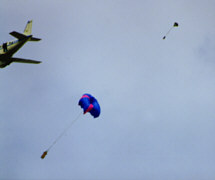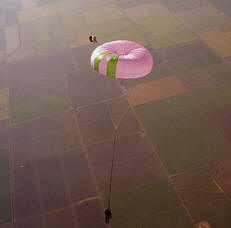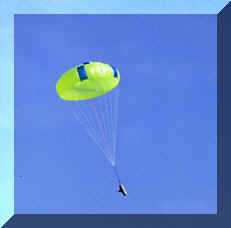The attached graph illustrates how the Quantum Series
Parachutes compare with the older generation of hang gliding parachutes.
Flight Performance
Comparison Chart
High Energy Sports’ Quantum Series Parachutes are the most
sophisticated, highly engineered and highly tested parachutes ever produced for
hang gliding. The sizes reflect the square footage in the canopy. Since we have achieved
"lift" in this design, the traditional formulas used to calculate rate of
descent do not work. All these figures come from actual test jumps we made with the
parachutes. Our instrument package gives us readings 17 times per second and is altitude
density compensated.
| We are particularly excited about this
design due to the extremely low rate of descent we have been able to achieve. Not only do
the Quantum Series Parachutes generate drag but they also produce lift thus bringing the
pilot down very slowly. We think a slow rate of descent is extremely important Often we
see broken hang gliders spinning. The spinning glider may be descending relatively slow.
If your parachute has a rate of descent faster than you are falling it will not open and
the "wind mill effect" may take place. The faster you are falling the faster the
broken wing will spin. The more you spin under an open canopy, the greater your chances of
twisting the bridle and eventually the lines of your parachute. This twist can continue
until the parachute lines get short enough to close the parachute altogether. |
|
| Some people argue that if you are descending
too slowly to open your parachute, your are going too slow to get hurt. That is totally
wrong! They continue to cite the incredible safety record we have enjoyed when people have
deployed their parachutes in the past. We believe that we have just been very lucky. |
The other benefits to coming down under canopy are: 1. The opening of the parachute may
disrupt the momentum of the spin and help slow it down, 2. If you are coming down under
canopy slower than the stall speed of the part of the wing that is still flying and
causing the spin, your chances of spinning are greatly reduced and 3. The slower you come
down the greater your chances of not getting hurt.
We use standard parachute construction techniques with full radial tape along the seams
and Kevlar reinforcement tape at the apex and skirt. In addition we have utilized a
combination of spectra and nylon for each line. The spectra gives us light weight, low
volume benefits while the nylon gives us the stretch characteristics desirable for higher
speed deployments.
We are very excited about the Quantum Series Parachutes and the extra margin of safety
they bring to our sport. If you have any questions or concerns please do not hesitate to
write or call.
Fly Safely,
Betty
Paraswivel: This addition to your parachute bridle was
designed to help prevent bridle twisting during a spinning descent. It is installed near
your canopy lines.
Parachute Container: See Parachute container section.
Bridle Replacement: You can have your current parachute updated with a new bridle
complete with bridle cover.
Parachute Repack: High Energy Sports can inspect and repack your parachute at any
time. If you have a hand deployed chute we strongly recommend that you do a practice
deployment on the ground before you send your parachute in for a repack.
Deployment Bag: High-Energy Sports deployment bag fully encloses canopy and lines
for a staged deployment. The opening has been placed towards the top of the deployment bag
so the chance of premature line or canopy dumping due to weakened rubber bands is
minimized.


